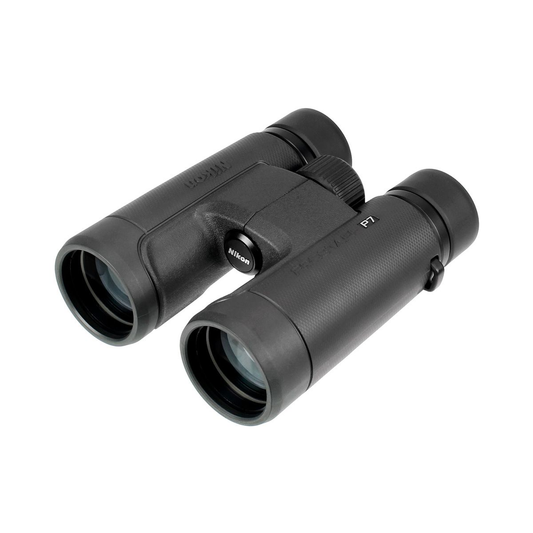

The Nikon PROSTAFF P7 10x42 Binoculars deliver exceptional optical performance tailored for outdoor enthusiasts. With 42mm objective lenses, these binoculars gather ample light, ensuring bright and clear images even in low-light conditions. The dielectric high-reflective multilayer prism coatings enhance color accuracy, making them ideal for early morning or late evening viewing. The phase-correction coated roof prisms provide high resolution, ensuring you see every detail, while the ergonomic design allows for comfortable extended use. Built to withstand the rigors of outdoor adventures, the Nikon PROSTAFF P7 features a durable fiberglass-reinforced polycarbonate body and a rubber armor coating that protects against impacts. The turn-and-slide eyecups and locking diopter ring ensure a customizable and secure fit for all users, whether wearing glasses or not. Plus, the eco-friendly glass ensures responsible use without compromising on performance. These binoculars are a reliable choice for anyone serious about birdwatching, hunting, or enjoying nature's beauty.
Key Features:
- OPTICAL EXCELLENCE: High-reflective coatings increase light transmission for clear viewing in low light.
- ENVIRONMENTALLY CONSCIOUS: Lead- and arsenic-free eco-glass for responsible use.
- USER COMFORT: Turn-and-slide rubber eyecups adapt to all users, with or without eyeglasses.
- RELIABLE DURABILITY: Reinforced polycarbonate resin body and rubber armored coating resist impacts.
- STEADY FOCUS: Locking diopter ring secures your settings against unintended changes.
- CRYSTAL CLEAR VISION: Phase-corrected prisms deliver sharp, high-resolution images.
- ALL-WEATHER READY: Water, fog, and dust resistance for uncompromised performance in the field.
- MAGNIFICATION POWER: 10x42 magnification for detailed observation of distant subjects.
Technical Specifications
| Specification | Details |
|---|---|
| Weight | 21.2 ounces |
| Dimensions | Length: 5.9 inches |
| Field of View | 367 feet @ 1000 yards |
| Objective Diameter | 42mm |
| Product Type | Binoculars |
| Item Condition | New |
| UPC | 018208167739 |
| MPN | 16773 |
What's in the Box?
- Nikon PROSTAFF P7 10x42 Binoculars (16773)
- Turn-and-slide rubber eyecups
- Locking diopter ring
- User manual
- Neck Strap
- Carrying Case
- Lens Covers
Customer Reviews
"These binoculars are perfect for birdwatching. The clarity is impressive, and I love the eco-friendly features!"
"Great for hunting! The low light performance really shines at dawn and dusk."
"Comfortable to use for long periods, and they withstand the rough outdoors without a hitch."
FAQ
Many users often wonder about the low-light performance of the Nikon PROSTAFF P7. Thanks to its 42mm objective lens and high-reflective coatings, these binoculars excel in low-light conditions, providing bright and clear images ideal for dawn or dusk viewing.
Maintenance is straightforward. Regularly clean the lenses with a soft, lint-free cloth to remove dust and smudges. The eco-glass construction means no special care is needed for environmental concerns, making them a hassle-free choice for outdoor activities.
When comparing the Nikon PROSTAFF P7 to other models, users frequently note that the combination of durability, optical quality, and comfort sets these binoculars apart from competitors in the same price range.
Similar Models
Looking for more options? Check out our range of Nikon binoculars, including the Nikon Aculon A211 10-22x50 for versatility in magnification and the Nikon Monarch 5 10x42 for advanced optical performance. Explore our full collection for exceptional optics tailored to your adventures.
You May Also Like
Here’s some of our most similar products people are buying. Click to discover trending style.










